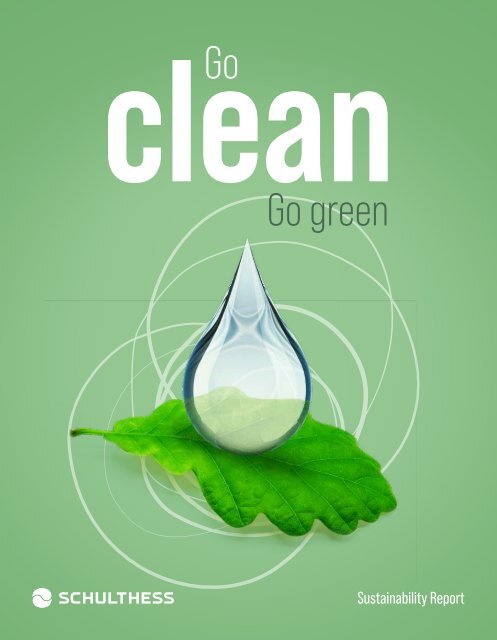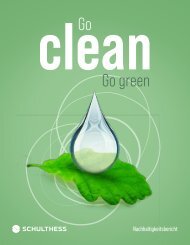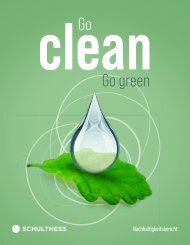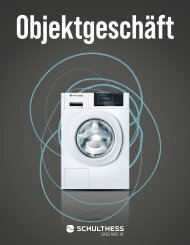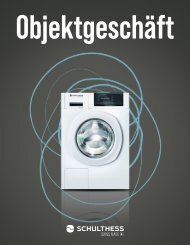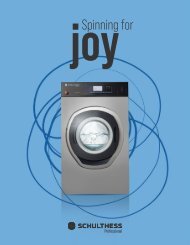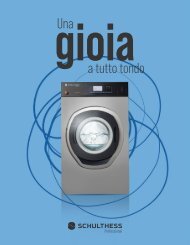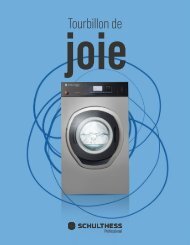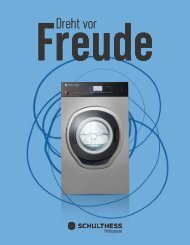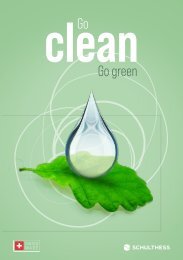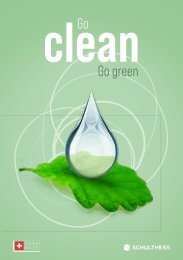Schulthess Nachhaltigkeitsbericht 2023
Create successful ePaper yourself
Turn your PDF publications into a flip-book with our unique Google optimized e-Paper software.
clean<br />
Go<br />
Go green<br />
Sustainability Report
Our production will<br />
be climate-neutral<br />
from 2030.<br />
Thomas Marder – CEO<br />
Dear Readers<br />
<strong>Schulthess</strong> has been the leading Swiss washing technology<br />
group since 1845. The long-established company stands for<br />
innovation in laundry care and is a pioneer in breaking new<br />
ground with the aim of simplifying our customers’ lives.<br />
In our corporate activities, we feel great responsibility towards<br />
our customers, employees, business partners, shareholders,<br />
society and the environment when it comes to sustainability.<br />
We have therefore set ourselves the goal of exclusively offering<br />
sustainable, resource-conserving premium products and<br />
services, establishing efficient processes for a functioning<br />
circular economy and climate-neutral production from 2030.<br />
To achieve this, we have identified sustainability as an essential<br />
part of our corporate strategy.<br />
Our sustainability management, supported by external expert<br />
partners, will henceforth concentrate on these essential<br />
fields of action. In this way, we will efficiently target those<br />
areas where we as a company have the greatest leverage.<br />
We will report on progress in these fields of action at twoyear<br />
intervals. The report is based on the Global Reporting<br />
Initiative (GRI) standards and follows a voluntary basis. We<br />
aim to show our customers, employees, business partners,<br />
shareholders and the interested public that we are serious<br />
about sustainability.<br />
I look forward to the journey together with you, dear<br />
readers, towards a sustainable future.
Contents<br />
01<br />
Sustainable Development Goals<br />
06<br />
02<br />
Company portrait<br />
<strong>Schulthess</strong> Maschinen AG 12<br />
Our corporate structure 13<br />
Organisation chart 14<br />
Our working method 15<br />
Code of Conduct 16<br />
Compliance 17<br />
04<br />
Environment and the<br />
circular economy<br />
Our carbon footprint 24<br />
Energy 28<br />
Products 32<br />
Durability 38<br />
Use phase 41<br />
Sharing Economy 42<br />
Mobility 44<br />
Waste, water, goods 46<br />
03 18<br />
Our materiality<br />
analysis<br />
05<br />
Working<br />
06<br />
at <strong>Schulthess</strong><br />
Interview Geraldine Fehr 52<br />
Occupational safety 53<br />
GRI list<br />
54<br />
P 04 P 05
Sustainable<br />
Development<br />
Goals
With our Sustainability Agenda 2030, we are contributing<br />
to the achievement of the United Nations Sustainable<br />
Development Goals (SDGs). The following SDGs are the focus<br />
of the <strong>Schulthess</strong> sustainability strategy:<br />
Affordable and clean energy<br />
<strong>Schulthess</strong> obtains 100% of its electricity<br />
from hydropower. The photovoltaic<br />
system at the Wolfhausen site has<br />
been in operation since 2022, making<br />
us even more energy independent. The<br />
share of self-produced solar power is<br />
gradually being increased.<br />
Industry, innovation and infrastructure<br />
<strong>Schulthess</strong> laundry solutions are as<br />
diverse as the high demands of commerce<br />
and industry. They set standards<br />
in the industry with great innovations<br />
in products and services. All appliances<br />
are easy to use and offer high process<br />
reliability.<br />
Responsible consumption and production<br />
<strong>Schulthess</strong> is continuously improv-<br />
Climate action<br />
<strong>Schulthess</strong>’s production will be cli-<br />
ing resource efficiency in production,<br />
mate-neutral by 2030. For this purpose,<br />
Good health and well-being<br />
Thanks to measures such as the 40-<br />
Gender equality<br />
<strong>Schulthess</strong> pays equal wages for equal<br />
Clean water and sanitation<br />
Thanks to the high efficiency of its<br />
transport, packaging, use and disposal.<br />
For example, <strong>Schulthess</strong> has reduced<br />
energy consumption per machine pro-<br />
we obtain 100% renewable electricity<br />
and are planning to expand the existing<br />
photovoltaic system. In addition, this<br />
hour week, at least five weeks’ holiday,<br />
work, leading to our certification in<br />
products, <strong>Schulthess</strong> helps save valua-<br />
duced by more than 36% from 2013 to<br />
goal is to be achieved through building<br />
our in-house health management and<br />
2021 by Landolt & Mächler Consult-<br />
ble drinking water. In 1975, a <strong>Schulthess</strong><br />
2022 – and will continue to make such<br />
renovations and the operation of the<br />
check-up, and improved ergonomics<br />
ants AG in accordance with the L&M-<br />
washing machine needed an average<br />
improvements. We are always working<br />
gas furnace with 100% biogas. More-<br />
in the workplace, we are improving the<br />
Aba-R® test procedure. We are proud<br />
of 55 litres of water per kilo of laun-<br />
to reduce the consumption of water,<br />
over, our entire service and business<br />
mental and physical health of our em-<br />
to pay fair and equitable wages to all<br />
dry washed. Today’s washing machine<br />
electricity and detergents.<br />
fleet, until now the largest in-house<br />
ployees.<br />
employees, regardless of gender, age<br />
needs only 6.8 litres, around 8 times<br />
source of emissions, will be electric by<br />
or nationality.<br />
less.<br />
2025.<br />
P 08 P 09
2<br />
Company<br />
portrait
34<br />
525<br />
employees<br />
Number of export<br />
countries<br />
<strong>Schulthess</strong> has been the leading<br />
Swiss washing technology group<br />
since 1845 and stands for innovation<br />
in laundry care. As a pioneer,<br />
<strong>Schulthess</strong> constantly breaks new<br />
ground with the aim of simplifying<br />
everyday life.<br />
This long-established Swiss company<br />
develops and produces highquality<br />
machines, systems and<br />
system solutions for private, commercial<br />
and industrial customers.<br />
National and international sales<br />
are supplemented by professional<br />
services. <strong>Schulthess</strong> appliances<br />
stand out for their high functionality,<br />
performance and durability,<br />
represent premium Swiss quality<br />
and are in use around the world.<br />
<strong>Schulthess</strong> Maschinen AG is ISO<br />
certified as follows: ISO 9001:2015<br />
Quality management systems,<br />
ISO 14001:2015 Environmental<br />
management systems and ISO<br />
45001:2018 Occupational health<br />
and safety management systems.<br />
<strong>Schulthess</strong> Maschinen AG has its<br />
headquarters in Cham ZG. Its production<br />
site is located in Wolfhausen<br />
ZH. In Switzerland, it has<br />
four other sites – Bern, Lucerne,<br />
Lamone TI and St-Sulpice VD –<br />
and two warehouses in Bad Ragaz<br />
SG and Satigny GE. <strong>Schulthess</strong><br />
Maschinen AG also has a number<br />
of overseas subsidiaries.<br />
Our corporate<br />
structure<br />
Holding company<br />
<strong>Schulthess</strong> Maschinen AG, Cham<br />
(head office)<br />
Subsidiaries<br />
<strong>Schulthess</strong> Produktion AG, Wolfhausen (CH)<br />
<strong>Schulthess</strong> Maschinen GmbH, Vienna<br />
Wolf Laundry Ltd, Barnsley (UK)<br />
Brewer & Bunney Ltd, Redruth (UK)<br />
GMP SRL, Minerbio (IT)<br />
Chemie AG, Ittigen (CH)<br />
Pee Gee Ltd, Middlesbrough (UK)<br />
Office in Shanghai (China)<br />
35 135<br />
machines in 2022<br />
62 398<br />
spare parts installed<br />
<strong>Schulthess</strong><br />
CHF<br />
134m<br />
Net revenue 2022<br />
Maschinen AG<br />
P<br />
S 12<br />
P 13
Organisation chart<br />
Holding company<br />
Management at <strong>Schulthess</strong> Maschinen AG consists of the following seven persons: Thomas<br />
Marder (CEO), Martin Keller (CFO), Nicole Thier (Head of Marketing), Samuel Wildhaber<br />
(Head of Professional), Micha Riedener (Head of Homecare), Manuel Seitz (Head of Service),<br />
Gianfranco Di Natale (Head of Laundry Technology) and Michael Winkler (Head of<br />
Production). (as at <strong>2023</strong>)<br />
Philipp Berner chairs the Board of Directors. Heinz Herren is Vice Chair of the Board of<br />
Directors. Other members of the Board of Directors are: Hans Backmann, Martin Keller,<br />
Torsten Gert-Erik Lindquist, Thomas Marder, Jürg Stöckli.<br />
<strong>Schulthess</strong> employs 525 people worldwide.<br />
Headcount 2021 2022<br />
Our<br />
working<br />
method<br />
<strong>Schulthess</strong> Maschinen AG, Cham (CH) 391 193<br />
<strong>Schulthess</strong> Produktion AG, Wolfhausen (CH) 199<br />
<strong>Schulthess</strong> Maschinen GmbH, Vienna 22 18<br />
Wolf Laundry Ltd, Barnsley (UK) 49 58<br />
Brewer & Bunney Ltd, Redruth (UK) &<br />
21 23<br />
Pee Gee Ltd, Middlesbrough (UK)<br />
Chemie AG, Ittigen (CH) 13<br />
GMP SRL, Minerbio (IT) 21<br />
Total 483 525<br />
The <strong>Schulthess</strong> culture is characterised by open and fair<br />
dealings among employees as well as with customers and<br />
partners. The <strong>Schulthess</strong> Code of Conduct serves as a<br />
guideline for action. <strong>Schulthess</strong> Maschinen AG is ISO certified<br />
under ISO 9001:2015 Quality management systems,<br />
ISO 14001:2015 Environmental management systems, ISO<br />
45001:2018 Occupational health and safety management<br />
systems. These certifications reflect our extensive process<br />
landscape. Every new employee is given access to the Code<br />
of Conduct on joining the company and is informed of its<br />
binding nature. The Code of Conduct contains guidelines on<br />
responsibility in the washing technology business, as an employer,<br />
for the environment and for the economy and society.<br />
Management positions at <strong>Schulthess</strong> are filled by individuals<br />
with integrity, strategic thinking, strong leadership skills and<br />
great team spirit. Communication between management and<br />
staff is open so that all staff can contribute. Only jointly can<br />
the company’s goals be achieved. <strong>Schulthess</strong>’s most important<br />
goal is to simplify everyday life in the long term with<br />
innovative washing technology.<br />
P 14<br />
P 15
Code of Conduct<br />
Compliance<br />
Martin Keller, how is fair competitive behaviour ensured?<br />
Responsibility in the washing<br />
technology business<br />
Responsible and long-term successful<br />
corporate governance<br />
Innovative, sustainable and competitive<br />
premium products<br />
Customer-oriented, efficient and environmentally<br />
friendly processes<br />
Adherence to laws (Compliance) as well as<br />
guidelines and standards (Conformance)<br />
Creating corporate value responsibly<br />
Responsibility as an employer<br />
Qualified and motivated employees as a<br />
decisive competitive factor<br />
Progressive working conditions<br />
Career and development opportunities<br />
Equality, diversity and integration in a<br />
multicultural environment<br />
Attracting, developing and retaining<br />
the best employees<br />
<strong>Schulthess</strong> adheres strictly to the rules of the game that apply<br />
in the Swiss and international business centre: Standards and<br />
laws according to the Swiss Code of Obligations, ISO standards or<br />
regulations on safety of the Federal Coordination Commission for<br />
Occupational Safety (FCOS). The Board of Directors reviews our<br />
risk management and internal control system every year. We also<br />
make sure that strategic information does not leave the company.<br />
Furthermore, our prices are reasonable, i.e. neither too high nor<br />
unrealistically low – which in turn could drive competitors away.<br />
Finally, our trading partners are also free from certain trading<br />
conditions.<br />
What are <strong>Schulthess</strong>’s governance and compliance goals?<br />
We have clear organisational, competence and signature rules:<br />
We apply the four-eyes principle to all weighty decisions. Those<br />
<strong>Schulthess</strong><br />
strictly<br />
adheres to<br />
the rules of<br />
the game.<br />
Responsibility for the environment<br />
Responsibility for the economy<br />
and society<br />
who work at <strong>Schulthess</strong> are trained in corporate values as well<br />
as risks. In addition, our annual financial statements are audited<br />
by an external auditor. Our accounts are prepared in accordance<br />
with International Financial Reporting Standards (IFRS). Furthermore,<br />
we do not supply products to sanctioned states.<br />
Martin Keller<br />
CFO <strong>Schulthess</strong> Maschinen AG<br />
Long-term environmental sustainability of our<br />
business activities<br />
Continuous improvement of our products,<br />
processes and infrastructure with regard to<br />
resource consumption and emissions<br />
Creating value for all stakeholders<br />
Promoting entrepreneurship<br />
Commitment and contribution as an employer,<br />
part of the economy and society<br />
What are <strong>Schulthess</strong>’s data protection goals and what<br />
measures are taken?<br />
Here, too, there are clear guidelines in the form of the New Federal<br />
Act on Data Protection. We also comply with the EU’s General<br />
Data Protection Regulation (GDPR). To comply with these require-<br />
Effective, efficient and sustainable use of<br />
Support for organisations, projects and causes<br />
ments, we have appointed an in-house Data Protection Officer.<br />
resources<br />
with shared values<br />
Environmental management as part of<br />
corporate governance<br />
Making an entrepreneurial contribution<br />
P 16<br />
P 17
Our<br />
materiality<br />
analysis
Focusing on and prioritising sustainable development over time is always a challenge,<br />
as the perspectives of companies, the environment and society may differ. Our materiality<br />
analysis shows which topics can be efficiently achieved with the greatest impact.<br />
The following areas and fields of action emerged as<br />
particularly relevant based on our materiality analysis:<br />
P 20<br />
This materiality analysis, based on the Global Reporting Initiative (GRI) standards,<br />
shows which fields of action need to be prioritised from the perspective of the company<br />
and its stakeholders. On pages 56 and 57 you will find the complete list of topics<br />
covered.<br />
To open up the view and take an absolute outside perspective,<br />
<strong>Schulthess</strong> enlisted the support of an external agency<br />
for its materiality analysis. In a first step, the areas and their<br />
fields of action for which the materiality analysis was to be<br />
carried out were defined in a workshop. For the definition<br />
of these fields of action, the company’s own characteristics,<br />
sector-specific aspects and the Global Reporting Initiative<br />
(GRI) standards were taken into account. As part of a<br />
five-stage online survey, internal (management) and external<br />
stakeholders (employees, customers and partners) were<br />
asked to give their assessment of the relevance of various<br />
fields of action.<br />
<strong>Schulthess</strong> conducted a<br />
materiality analysis<br />
as the starting point of its<br />
sustainability strategy.<br />
i<br />
The resulting materiality matrix shows which issues have the<br />
strongest economic, environmental and social impacts and,<br />
at the same time, the greatest influence on stakeholder assessment<br />
and decision-making. This resulted in four major<br />
areas of sustainability in which <strong>Schulthess</strong> is to be involved:<br />
corporate governance, products, commitment to the environment<br />
and climate, as well as to employees and society.<br />
Within these fields, the analysis made it clear in detail in<br />
which fields of action <strong>Schulthess</strong> has the greatest leverage<br />
for positive developments. The strategic orientation of management’s<br />
environmental goals is broken down to the individual<br />
business units. The degree of achievement of these<br />
targets of
04<br />
Environment<br />
and the circular<br />
economy
Our carbon<br />
footprint<br />
Climate-neutral<br />
Scope 3<br />
Purchased goods<br />
and services 89%<br />
(17 815 t CO2eq)<br />
Scope 3<br />
Other emissions 6%<br />
(1268 t CO2eq)<br />
Scope 1<br />
Direct greenhouse gas emissions refer to direct emissions<br />
from sources owned or controlled by the company. These are<br />
those from the combustion of oil and gas to generate heat,<br />
as well as emissions from the fleet. Scope 1 and 2 emissions<br />
have been recorded since 2003.<br />
<br />
894 t CO2eq<br />
Scope 2<br />
Indirect greenhouse gas emissions from energy purchases<br />
refer to those emissions that occur when the energy purchased<br />
by <strong>Schulthess</strong> (electricity, district heating/cooling,<br />
steam) is generated by the supplier. As <strong>Schulthess</strong> only purchases<br />
electricity from hydropower, there are no Scope 2<br />
emissions (not shown).<br />
<br />
0 t CO2eq<br />
Scope 3<br />
Other indirect greenhouse gas emissions associated with all<br />
other activities of an organisation with third parties can occur<br />
both upstream and downstream of <strong>Schulthess</strong>. Taking<br />
Scope 3 emissions into account, over 95% of emissions occur<br />
in the upstream and downstream supply chains, particularly<br />
in purchased goods and services and in the use phase<br />
by end users.<br />
by 2030<br />
<br />
Total<br />
19 083 t CO2eq<br />
19 978 t CO2eq<br />
We are pursuing the goal of climate-neutral production by 2030 and constantly improving<br />
the climate compatibility of our products and business activities. We have calculated<br />
our carbon footprint according to international standards in order to identify<br />
effective measures and make our contribution to achieving international climate targets.<br />
The limitations result from the fact that only the <strong>Schulthess</strong> sites were included<br />
in the calculation.<br />
Scope 1:<br />
Direct emissions<br />
Gas 1%<br />
(124 t CO2eq)<br />
Scope 1:<br />
Direct emissions<br />
Heating oil
Scope 1: Direct emissions<br />
The products category accounts, at 16 780 t CO2eq, for 84%<br />
of emissions. The majority of this is generated in the produc-<br />
Emissions from the provision of fresh water and the treatment<br />
of wastewater are in the per thousand range. The waste cat-<br />
Direct emissions t CO2eq<br />
1400<br />
1200<br />
1000<br />
800<br />
600<br />
400<br />
200<br />
0<br />
13,6<br />
12,2 12,3 12,3<br />
13,0<br />
2013 2014 2015 2016 2017 2018 2019 2020 2021 2022<br />
11,7<br />
11,0<br />
9,9 10,2<br />
8,0<br />
16<br />
14<br />
12<br />
10<br />
8<br />
6<br />
4<br />
2<br />
0<br />
t CO2eq per CHFm of revenue<br />
tion of raw materials in the upstream supply chains, and the<br />
relatively small proportion in the downstream transport and<br />
in the disposal of machines.<br />
The emissions in the mobility category are made up of direct<br />
emissions from the combustion of fuels on the one hand,<br />
and indirect emissions from commuting and business transport<br />
on the other. With a total of 1 295 t CO2eq, the mobility<br />
category accounts for around 6% of the footprint.<br />
The goods category contributes 1 609 t CO2eq to the footprint<br />
and includes the auxiliary materials and consumables in production<br />
in Wolfhausen as well as the commercial products<br />
egory includes the emissions generated during the processing<br />
of the waste produced at the Wolfhausen plant.<br />
The use phase of our products causes an estimated 200 000 t<br />
of CO 2<br />
. The emissions in this category come from the production<br />
and provision of electricity and water for the operation<br />
of <strong>Schulthess</strong> machines and are largely dependent<br />
on whether the electricity comes from renewable or fossil<br />
sources. The use phase is not part of the system under consideration.<br />
that <strong>Schulthess</strong> distributes.<br />
Heating oil consumption<br />
Gas consumption<br />
Fuel consumption<br />
t CO2eq per CHFm of revenue<br />
The energy category (262 t CO2eq) includes on the one hand<br />
the direct emissions from the combustion of regular fuels<br />
(182 t CO2eq), and on the other hand the upstream indirect<br />
emissions (80 t CO2eq) necessary for the production of pur-<br />
i<br />
In Scope 3, those categories were sur-<br />
chased energy and for the production of regular fuels.<br />
41%<br />
less CO₂ emissions from<br />
combustibles and fuels<br />
compared to 2013<br />
veyed that are necessary for direct operational<br />
work and can be directly influenced<br />
in the short and medium term.<br />
The categories lessees, processing of<br />
sold intermediate products, franchises<br />
and investments were not<br />
taken into account. In addition,<br />
the indirect emission sources<br />
that are absolutely necessary,<br />
such as production machines<br />
and office equipment, were not<br />
surveyed.<br />
To make the results more accessible,<br />
the various direct and indirect<br />
emission sources were assigned to the<br />
Scope 3 emissions<br />
Use phase:<br />
up to 200 000 t CO2eq.<br />
By far the largest<br />
share of emissions,<br />
over 90%, comes<br />
from the use<br />
of products sold.<br />
categories energy, goods, products,<br />
water, mobility and waste.<br />
Energy 262 t CO2eq, 1% Mobility 1 295 t CO2eq, 6%<br />
Waste 32 t CO2eq,
Energy<br />
Energy consumption<br />
<strong>Schulthess</strong> emitted 262 t CO2eq in 2022 due to energy-related activities, of which 85% (221 t CO2eq) was<br />
attributable to direct and indirect emissions from space and process heating and 15% (41 t CO2eq) to purchased<br />
electricity.<br />
<strong>Schulthess</strong> has been working with the Energy Agency for Industry (EnAW) since 2003 to continuously reduce<br />
energy consumption and direct emissions. Since 2013, <strong>Schulthess</strong> has reduced its direct greenhouse gas<br />
emissions caused by fuels by 62% from 476 tonnes to 182 t CO2eq, with a 40% increase in production. This<br />
was achieved through various measures such as the installation of a photovoltaic system, the commissioning<br />
of a heat pump and the use of waste heat from the compressors and of process heat.<br />
The target agreement with EnAW stipulates that <strong>Schulthess</strong> will reduce greenhouse gas emissions due to<br />
heating oil and gas to 286 t CO2eq by 2024. <strong>Schulthess</strong> voluntarily plans to be able to operate production<br />
at the site without direct emissions by 2030.<br />
Energy consumption MWh<br />
4500<br />
4000<br />
3500<br />
3000<br />
2500<br />
2000<br />
1500<br />
1000<br />
500<br />
152<br />
139 142<br />
128<br />
116<br />
111<br />
104<br />
95<br />
89<br />
83<br />
160<br />
140<br />
120<br />
100<br />
80<br />
60<br />
40<br />
20<br />
kWh per machine<br />
<strong>Schulthess</strong>’s total energy consumption in 2022 was 2 904 MWh. Of this, 60% (1 743 MWh) of the energy<br />
was consumed in the form of electricity, 8% (219 MWh) in the form of heating oil and 21% (615 MWh) in<br />
the form of gas. Total energy consumption has remained roughly constant over the past decade, but energy<br />
consumption per machine has been reduced by 45% from over 150 kWh to under 100 kWh over the same<br />
period.<br />
0<br />
2013 2014 2015 2016 2017 2018 2019 2020 2021 2022<br />
Electricity consumption<br />
Gas consumption<br />
Heating oil<br />
consumption<br />
District heating<br />
0<br />
Energy consumption<br />
per machine<br />
Primary energy consumption<br />
To achieve our targets for reducing direct greenhouse gas<br />
Space heating<br />
Until 2021, space heating at <strong>Schulthess</strong> was primarily gen-<br />
emissions, we are planning several measures:<br />
erated with an oil-fired boiler, resulting in emissions of 212 t<br />
Process heat<br />
The manufacture of our products requires heat to burn in<br />
CO2eq in 2021. In summer 2022, a heat pump was commissioned<br />
to cover the base load. Thus, in the winter of<br />
2022/<strong>2023</strong>, emissions from oil consumption were already<br />
the paints of our machines and make them long-lasting. This<br />
significantly reduced to 58 t CO2eq. In connection with this<br />
process heat is generated in the production in our own pow-<br />
conversion work, the oil burner was also replaced by a more<br />
der coating plant using natural gas. Currently, a natural gas/<br />
efficient gas burner in 2022 to break the peaks in energy<br />
−45%<br />
biogas mix is used; with the switch to 100% biogas, these<br />
emissions can be completely replaced by renewable energies<br />
demand during particularly cold winters. In the medium term,<br />
we will replace natural gas for heating with biogas from bio-<br />
by 2030. In addition, there are plans to further expand heat<br />
mass and plan to expand the heat pump centre.<br />
recovery in powder coating and use it to generate hot water<br />
2013<br />
Energy consumption per<br />
machine: 152 kWh<br />
2022<br />
Energy consumption per<br />
machine: 83 kWh<br />
and space heating.<br />
P 28 P 29
Energy<br />
Primary energy in GWh<br />
5.00<br />
4.50<br />
4.00<br />
3.50<br />
3.00<br />
2.50<br />
2.00<br />
1.50<br />
700<br />
600<br />
500<br />
400<br />
300<br />
200<br />
Emissions in t CO2eq<br />
Electricity<br />
<strong>Schulthess</strong> obtains all its electricity from hydropower. In addition,<br />
we can cover 20% of the electricity demand with solar<br />
power. A doubling of the output is planned through further<br />
panels.<br />
Thus the renewable electricity from the photovoltaic system<br />
supplies the consumption of production, heat pumps and<br />
electromobility. <strong>Schulthess</strong> will feed the surplus electricity<br />
into the grid in the near term. In the long term, we plan to<br />
store this battery-electrically for our own use. If more electricity<br />
is needed than the photovoltaic system can supply,<br />
electricity will continue to be drawn from hydropower.<br />
1.00<br />
0.50<br />
0.00<br />
Space heating oil<br />
2013<br />
2014<br />
2015<br />
2016<br />
2017<br />
Process energy gas<br />
2018<br />
2019<br />
2020<br />
2021<br />
Heating energy gas<br />
2022<br />
<strong>2023</strong><br />
2024<br />
2025<br />
2026<br />
Electricity consumption<br />
2027<br />
2028<br />
2029<br />
2030<br />
100<br />
0<br />
t CO2eq per CHFm<br />
of revenue<br />
i<br />
<strong>Schulthess</strong> will operate production at<br />
the Wolfhausen site without<br />
direct emissions by 2030. Energy<br />
demand will increase continuously<br />
due to planned production<br />
increases and will be met with<br />
100% sustainable electricity.<br />
We obtain<br />
100%<br />
electricity from<br />
hydropower<br />
P 30 P 31
Products<br />
With almost 85% of the total emissions, the activities and<br />
materials around the manufactured products are the largest<br />
controllable emission category with 16 780 t CO2eq.<br />
<strong>Schulthess</strong> processed around 4 000 tonnes of materials in<br />
the reference year, of which around 70% consisted of ferritic<br />
steel. The materials processed in production account for<br />
around 95% of the indirect emissions in this category, with<br />
the remainder distributed among transport, packaging and<br />
disposal of the products.<br />
Transparency about the materials used and the emissions<br />
they cause in the upstream supply chain makes it possible<br />
to plan and implement projects to reduce climate-relevant<br />
emissions in a targeted and effective manner.<br />
Computer-based calculation procedures<br />
With the help of computer-aided models, continuous improvements are being made to various machine components. With<br />
these optimisations, materials can be used more efficiently with the same or better stiffness, thereby reducing the CO 2<br />
impact.<br />
Thanks to such development projects, for example, up to 32 tonnes of sheet metal will be saved annually in the Homecare<br />
range and up to 20 tonnes of cast iron in the Professional range in the future – equivalent to an annual savings potential<br />
of up to 100 t CO2eq.<br />
Materials production<br />
16 040 t CO2eq<br />
Sheet metal 40%<br />
Electronics 27%<br />
Plastics 7%<br />
Non-ferrous metals 7%<br />
Ferrous metals 7%<br />
Electric drives 5%<br />
Machine elements 1%<br />
Glass
Packaging and transport<br />
<strong>Schulthess</strong> consumes around 200 tonnes of packaging material<br />
per year, which indirectly causes around 175 t CO2eq.<br />
Where possible, we reuse the wooden frames for our machines<br />
and are working to introduce alternative packaging<br />
based on renewable resources. This is especially true under<br />
the aspect of the disproportionately high CO 2<br />
intensity of<br />
plastic and polystyrene.<br />
We do everything we can to constantly improve the distribution<br />
of our products, for example through optimised packaging.<br />
In the Professional range, stackable packaging now<br />
allows twice as many proLine washing machines to be loaded<br />
per transport, resulting in emission savings of 45%.<br />
i<br />
In the Professional range, stackable packaging<br />
now allows twice as many proLine washing<br />
machines to be loaded per transport, resulting<br />
in emission savings of 45%.<br />
100%<br />
90%<br />
80%<br />
70%<br />
60%<br />
50%<br />
40%<br />
30%<br />
20%<br />
10%<br />
0%<br />
137t consumption,<br />
equivalent to 68%<br />
39t consumption,<br />
equivalent to 19%<br />
27t consumption,<br />
equivalent to 13%<br />
Tonnage<br />
42t CO2 emissions,<br />
equivalent to 24%<br />
36t CO2 emissions,<br />
equivalent to 21%<br />
96t CO2 emissions,<br />
equivalent to 55%<br />
t CO2eq<br />
Wood<br />
Cardboard<br />
Plastics<br />
P 35
In 2022<br />
<strong>Schulthess</strong><br />
built<br />
62 398<br />
spare parts.
Durability<br />
Thanks to quality<br />
and repairability<br />
<strong>Schulthess</strong> machines are durable due to their high quality Switzerland and keep all parts available over several generations<br />
of appliances. For our Homecare machines, we allow a<br />
and good repairability. The machines owe their robustness<br />
to the choice of materials and their design. For example, spare parts availability of up to 12 years, and for machines in<br />
the outer and inner drums of all <strong>Schulthess</strong> washing machines<br />
are made of high-quality chrome steel, where the<br />
the Professional range of up to 18 years.<br />
market standard is plastic. The benefits are obvious: They The repairability of our products, measured in standardised<br />
are extremely durable, recyclable and also very hygienic. In procedures, is already above the industry average. Our stated<br />
aim is to be among the best in repairability for all new<br />
the Homecare range, our machines are designed and tested<br />
for 9 000 wash cycles, which in a household means a fatigue developments, which can be achieved, among other things,<br />
strength of wear parts of up to 30 years. In the case of machines<br />
for apartment blocks, the figure is as high as 24 000 extended audience.<br />
by making spare parts and repair manuals available to an<br />
cycles, and 40 000 wash cycles for machines for professional<br />
laundries.<br />
A continuous improvement in repairability and ability to dismantle<br />
has a particularly large potential in the reuse of used<br />
To ensure quick repairs, 160 service specialists and 120 service<br />
vehicles are on duty throughout Switzerland. For all our castings. If, for example, 10% of the electric drives can be<br />
long-life components such as electric drives or aluminium<br />
machines we offer a warranty extension for up to 12 years used in a second life cycle, 190 t CO2eq can be saved. If 20%<br />
from purchase. Our customer service will repair the machines of the aluminium castings can be used for a second life cycle,<br />
146 t CO2eq can be saved, roughly equivalent to the cur-<br />
at a fair price even after many years. We manage to do this<br />
because we store our spare parts at the production site in rent direct emissions for generating space and process heat.<br />
Up to<br />
12 years<br />
spare parts availability<br />
for machines in the<br />
Homecare range<br />
Up to<br />
18 years<br />
spare parts availability<br />
for machines in the<br />
Professional range<br />
P 38<br />
P 39
Our 87-year-old customer Eugen Sommer-Leimgruber<br />
still owns a <strong>Schulthess</strong><br />
machine from 1966. Thanks to regular<br />
repairs and careful maintenance, his<br />
<strong>Schulthess</strong> Super 4 still runs perfectly<br />
today. However, due to the machine’s increased<br />
energy and water consumption, he<br />
has now decided to replace his <strong>Schulthess</strong><br />
machine. For his customer loyalty, we are<br />
giving him a new <strong>Schulthess</strong> Spirit 530<br />
machine.<br />
Use phase<br />
Our survey shows that the emissions generated annually by<br />
the use of our machines are around ten times higher than<br />
the emissions we emit directly and indirectly through our<br />
business activities. With a minimum service life of at least<br />
ten years, more than 90% of the emissions from <strong>Schulthess</strong><br />
products are therefore generated during washing and drying<br />
at the customer’s premises. We are aware of our responsibility<br />
and are constantly improving the efficiency of our machines.<br />
Our washing machines in the Homecare range are certified<br />
with the highest energy label A. For the new energy labels for<br />
dryers, awarded since <strong>2023</strong>, we are also aiming for the best<br />
class. In particular, we would like to motivate our customers<br />
with awareness campaigns to operate our machines with<br />
100% renewable energies in order to sustainably achieve<br />
our common climate goals.<br />
A<br />
All Homecare washing<br />
machines carry the highest<br />
energy label<br />
Energy consumption kWh/kg<br />
Energy consumption kWh/kg<br />
Water consumption l/kg<br />
Water cons<br />
1975<br />
1975<br />
0.49<br />
0.49<br />
1975<br />
55<br />
1985<br />
1991<br />
0.30<br />
0.25<br />
1985<br />
1991<br />
0.30<br />
0.25<br />
2006<br />
Today<br />
0.17<br />
0.08<br />
2006<br />
Today<br />
0.17<br />
0.08<br />
20<br />
14<br />
1985<br />
1991<br />
7.8<br />
6.8<br />
2006<br />
Today<br />
P 41
<strong>Schulthess</strong> – part<br />
of the sharing<br />
The alternative financing models increase longevity, as maintenance<br />
and repairs are the responsibility of <strong>Schulthess</strong><br />
and are therefore always carried out professionally and on<br />
time. By sharing a machine, the resources consumed and<br />
the energy used for delivery and maintenance can be divided<br />
among more than one person, reducing the ecological footprint<br />
per person. Thanks to these new business models, we<br />
are also involved at the end of the product life cycle. In this<br />
way, we can ensure that the material cycles are closed as<br />
far as possible through correct recycling. These activities will<br />
also allow resource-intensive materials to be recycled and<br />
reused in the future.<br />
economy<br />
<strong>Schulthess</strong> offers various financing models for washing machines.<br />
For example, customers can opt for pay per use,<br />
rental or leasing instead of a classic purchase contract. All<br />
three models require no initial investment, and maintenance<br />
and repairs are included. These three alternative financing<br />
systems also give property owners with smaller budgets access<br />
to high-quality and environmentally friendly washing<br />
machines.<br />
Pay per use Rental Leasing<br />
With pay per use, customers<br />
provide the laundry room and<br />
<strong>Schulthess</strong> is responsible for operating<br />
the machines. Charging is per<br />
wash cycle.<br />
The rental model works according<br />
to a fixed price model. Customers<br />
do not pay per wash cycle, but per<br />
defined time period.<br />
In the leasing model, the machine<br />
is paid off over a fixed period of<br />
time. During this time, maintenance<br />
and appliance warranty<br />
costs are waived by customer<br />
service.<br />
10-year contract 10-year contract Defined period<br />
No initial investment No initial investment No initial investment<br />
No maintenance or repair costs<br />
No maintenance or repair costs<br />
P 42 P 43
Mobility<br />
The mobility category covers commuting by employees as well as business transport, for example of service staff. In 2022,<br />
<strong>Schulthess</strong> had 112 service vehicles and 36 company vehicles in use. Operating these vehicles consumed 15 650 litres of<br />
petrol and 258 000 litres of diesel. On a six-year average, consumption per thousand francs of service revenue (TCHF service<br />
revenue) was reduced by 13%.<br />
9.40<br />
9.20<br />
9.00<br />
i<br />
At 712 t CO2eq, the fuel consumption of the<br />
vehicle fleet accounts for the largest<br />
share of direct emissions. These direct<br />
emissions will be saved by 2030 thanks<br />
to the changeover to electromobility.<br />
8.80<br />
8.60<br />
8.40<br />
8.20<br />
8.00<br />
7.80<br />
7.60<br />
2017 2018 2019 2020 2021<br />
2022<br />
Commuting by car<br />
112 t CO2eq, 9%<br />
Electric fleet<br />
By 2030, our entire vehicle fleet will be battery-electric in order<br />
to reduce direct emissions from mobility to zero. New vehicles<br />
will only be procured as electric cars as standard. This<br />
changeover has already begun for employee vehicles, and the<br />
first service vehicles with sustainable electricity have been<br />
on Swiss roads since 2022.The electricity for charging the<br />
batteries of the e-vehicles, in use since 2022, is charged<br />
whenever possible via the photovoltaic system planned for<br />
the same year.<br />
Consumption in litres per TCHF service revenue<br />
Commuting with electric vehicles and public transport<br />
<strong>Schulthess</strong> encourages travel to the place of work by public<br />
transport and fully covers the cost of a season ticket from<br />
home to the place of work. Commuting by car accounts for<br />
some 9% of <strong>Schulthess</strong>’s mobility emissions. Employees can<br />
receive discounts on new cars from <strong>Schulthess</strong>’s partners,<br />
but these absolutely must be electric.<br />
Thanks to our home office offer (see chapter on “Working at<br />
<strong>Schulthess</strong>”), additional emissions can be saved in commuting<br />
because the commute to work is no longer necessary.<br />
Fuel emissions<br />
712 t CO2eq, 56%<br />
Aviation<br />
42 t CO2eq, 2%<br />
Commuting by public<br />
transport<br />
10 t CO2eq, 1%<br />
Manufacturer emissions fleet<br />
416 t CO2eq, 32%<br />
P 44 P 45
Waste<br />
In the year under review, just under 1 100 tonnes of waste<br />
were generated at the Wolfhausen site. The largest proportion<br />
by weight was metal recycling waste (64%), followed<br />
by wood and cardboard (12% each) and MWIP waste (8%).<br />
We constantly strive to optimise our processes and reduce<br />
the amount of waste we produce. Since 2017, we have had<br />
the goal of producing less than 3kg of MWIP and hazardous<br />
waste per machine sold. This goal is also part of the<br />
environmental management, certified under ISO 14001:2015<br />
Environmental management systems. In our designs and developments,<br />
we pay attention to the purity of materials so<br />
that they can be cleanly separated in production and recycling.<br />
We also work closely with our suppliers to reduce the<br />
almost 300 tonnes of wood and cardboard waste generated,<br />
most of which is attributable to the packaging of machine<br />
elements and semi-finished products, for example by using<br />
returnable packaging.<br />
Water<br />
In 2021, we consumed 8 842 m³ of water at the Wolfhausen site.<br />
We use water sparingly and are constantly improving the efficiency<br />
of buildings and production processes that use water.<br />
About 2% of the water is used for testing the washing machines<br />
and about 10% for pretreatment and cleaning of the<br />
parts before powder coating, the rest being industrial water.<br />
Goods<br />
The goods category, which accounts for around 8% of annual<br />
emissions, includes indirect emissions that do not directly affect<br />
the manufacture of our products. This category includes,<br />
among others, the more than 300 tonnes of commercial products<br />
that we offer as part of our portfolio. We make sure that<br />
these commercial products are manufactured in or near Switzerland<br />
to keep the associated emissions as low as possible.<br />
Paper consumption accounts for 10 tonnes per year and<br />
causes about 10.2 t CO2eq. Most paper consumption is due<br />
to the provision of printed operating and service manuals.<br />
We can only partially eliminate or digitise this paper consumption,<br />
as we are legally obliged to deliver certain documents<br />
with the machines. However, all manuals are also<br />
available online.<br />
P 46 P 47
Working at<br />
<strong>Schulthess</strong><br />
P 48
40-hour<br />
week¹<br />
5 to 6<br />
weeks’<br />
holiday²<br />
As a Swiss company, <strong>Schulthess</strong>’s highest goal is to manufacture<br />
high-quality machines and provide outstanding<br />
service to its customers. To achieve this, we depend<br />
on motivated and autonomous employees. <strong>Schulthess</strong><br />
therefore offers attractive working conditions, a comprehensive<br />
health plan and good social benefits.<br />
In 2022, <strong>Schulthess</strong> had 525 employees (<strong>Schulthess</strong><br />
Maschinen AG and <strong>Schulthess</strong> Produktion AG).<br />
As a solution provider of washing technology, <strong>Schulthess</strong><br />
can count on the expertise of many long-serving employees.<br />
The net turnover rate is 5.48%.<br />
At the end of the year under review, 80% of <strong>Schulthess</strong>’s<br />
workforce was male and 20% female. In leadership positions,<br />
the ratio is 87.5% men to 12.5% women. Management<br />
consists of six men and one woman (GRI 405-1).<br />
Equal<br />
pay for equal<br />
work³<br />
Maternity and<br />
paternity leave<br />
with<br />
full pay<br />
Support<br />
for further<br />
training⁴<br />
Up to 50%<br />
in the<br />
home office<br />
16 weeks’<br />
maternity<br />
leave<br />
1<br />
Service technicians work 42-hour weeks, as do delivery and installation staff.<br />
2<br />
3<br />
Employees up to the age of 40 are entitled to 25 days’ holiday per year if they work<br />
full-time, rising to 27 days’ holiday thereafter and to 30 days’ holiday per year from<br />
the age of 50.<br />
<strong>Schulthess</strong> Maschinen AG complies with equal pay for men and women in<br />
accordance with Article 8 of the Federal Constitution; there is no significant gender<br />
pay gap. In the year under review, <strong>Schulthess</strong> was certified by Landolt &<br />
Mächler Consultants AG in accordance with the L&M-Aba-R® test procedure<br />
(specification 405-2).<br />
4 We support our employees in training and further education. As a rule, <strong>Schulthess</strong><br />
pays two thirds of the costs. Individual solutions are developed together with the<br />
employees.<br />
Electric fleet<br />
By 2030, our entire vehicle fleet will be battery-electric<br />
in order to reduce direct emissions from mobility<br />
to zero. New vehicles will only be procured as electric<br />
cars as standard. This changeover has already<br />
begun for employee vehicles, and the first service<br />
vehicles with sustainable electricity have been on<br />
Swiss roads since 2022.The electricity for charging<br />
the batteries of the e-vehicles, in use since 2022,<br />
is charged whenever possible via the photovoltaic<br />
system planned for the same year.<br />
P 50<br />
P 51
Geraldine Fehr, what makes <strong>Schulthess</strong> particularly<br />
attractive as an employer?<br />
We produce in Switzerland, which means that customers<br />
can expect a high standard of quality. <strong>Schulthess</strong><br />
knows that it can only offer this if its employees are<br />
motivated and share a passion for its products. Which<br />
is why our company offers industry-appropriate wages<br />
with profit sharing as well as attractive social benefits.<br />
Our employees are also covered by the Collective<br />
Labour Agreement for the Mechanical, Electrical and<br />
Metal Industries (GAV Swissmem), which ensures fair<br />
conditions.<br />
What is <strong>Schulthess</strong>’s human resources philosophy?<br />
<strong>Schulthess</strong> has flat hierarchies and encourages its<br />
employees to work autonomously. At <strong>Schulthess</strong>, you<br />
can bring in and implement your own ideas, which<br />
means that everyone in the company can make a difference.<br />
Furthermore, employee health is central: The<br />
company’s in-house health management – for example<br />
by promoting ergonomic workplaces – promotes<br />
wellbeing. The 40-hour week and flexible working<br />
hours improve the work/life balance.<br />
Is <strong>Schulthess</strong> a family-friendly company?<br />
Our female employees are entitled to 16 weeks’ maternity<br />
leave, two more than stipulated by law. During<br />
this time, the full wage is also paid, not just the<br />
mandatory 80%. And new fathers also receive their<br />
full salary during the 14 days’ paternity leave. Whenever<br />
possible and desired, a change to part-time is<br />
made possible after the birth of children. Thanks to<br />
the eight-hour working day, flexible home-office options<br />
and flexitime, employees can organise their<br />
days well – or even rearrange them spontaneously if<br />
something unforeseen happens.<br />
At <strong>Schulthess</strong>,<br />
employees<br />
can implement<br />
their own<br />
ideas.<br />
Geraldine Fehr<br />
HR Business Partner<br />
Occupational<br />
safety<br />
<strong>Schulthess</strong> Maschinen AG wants to offer its employees a secure working environment.<br />
The company’s target is therefore to generate no more than 0.5% lost hours per year in<br />
relation to the annual target working hours. Although there were a total of 22 occupational<br />
accidents in 2022, most of them were minor (e.g. slight cuts, tripping). Even minor<br />
accidents are annoying and should be avoided as best as possible. Overall, internal measures<br />
such as communication campaigns, hazard matrix and targeted occupational safety<br />
training are having an impact: Managers and employees are made aware of hazards in<br />
the workplace and are better able to assume their own responsibility. <strong>Schulthess</strong> Maschinen<br />
AG is certified under ISO 45001:20218 (Occupational health and safety management<br />
systems).<br />
0.8<br />
0.7<br />
0.70<br />
0.6<br />
0.5<br />
0.4<br />
0.34 0.35<br />
0.3 0.23<br />
0.21<br />
0.2<br />
0.1<br />
Goal:<br />
No more than 0.5% lost<br />
hours per year<br />
in relation to annual<br />
working hours.<br />
0<br />
2018 2019 2020 2021 2022<br />
Hours lost in relation to annual target working hours<br />
Goal<br />
P 52<br />
P 53
GRI list
Business practice<br />
Topics: Our corporate structure / organisation chart<br />
GRI Description Page<br />
102 – General information Organisation profile 12/13/14<br />
Strategy 2/8/9/20/21<br />
Ethics and integrity (including Code of Conduct) 15/16/17<br />
Corporate governance 14<br />
Involvement of stakeholders 20/21<br />
Reporting procedure 2<br />
Topics: Company portrait<br />
GRI Description Page<br />
201 – Economic performance Information on the management approach 12<br />
Direct economic value generated 12<br />
Topics: Compliance<br />
GRI Description Page<br />
205 – Fighting corruption Information on the management approach 17<br />
Topics: Our carbon footprint<br />
GRI Description Page<br />
305 – Emissions Information on the management approach 24<br />
Direct GHG emissions (Scope 1) 25/26/27/44/45<br />
Indirect energy-related GHG emissions (Scope 2) 25<br />
Other indirect GHG emissions (Scope 3) 25/26/27/46<br />
Reduction of GHG emissions 30<br />
Topics: Mobility<br />
GRI Description Page<br />
305 – Emissions Information on the management approach 44<br />
Direct GHG emissions (Scope 1) 44/45<br />
Topics: Waste, water, goods<br />
GRI Description Page<br />
306 – Waste Information on the management approach 46<br />
Waste by type and disposal method 46<br />
Employees and society<br />
Fields of action: Working at <strong>Schulthess</strong><br />
GRI Description Page<br />
Environment and the circular economy<br />
Topics: Products<br />
GRI Description Page<br />
301 – Materials Information on the management approach 32<br />
401 – Employment Information on the management approach 51<br />
Newly hired employees and employee turnover 51<br />
Parental leave 50<br />
Fields of action: Occupational safety<br />
GRI Description Page<br />
Materials used by weight or volume 32<br />
Recycled products and their packaging materials 34/35<br />
Topics: Energy<br />
GRI Description Page<br />
302 – Energy Information on the management approach 28<br />
Energy consumption within the organisation 29<br />
Energy consumption per machine 29<br />
Reducing energy consumption 28/29/30<br />
Reducing the energy demand for products and services 28<br />
403 – Occupational safety and health<br />
protection<br />
405 – Diversity and equal opportunities<br />
Information on the management approach 53<br />
Management system for occupational safety 53<br />
Hazard identification, risk assessment and incident investigation 53<br />
Promoting the health of employees 52<br />
Work-related injuries 53<br />
Information on the management approach 51<br />
Diversity in supervisory bodies and among employees 51<br />
Ratio of women’s basic salary and remuneration to men’s basic salary and<br />
remuneration<br />
50
Publisher<br />
<strong>Schulthess</strong> Maschinen AG<br />
Alte Steinhauserstrasse 1<br />
6330 Cham<br />
Responsibility for content<br />
Nicole Thier (Member of Management),<br />
Head of Marketing & Communication<br />
Editorial<br />
Tobias Widmer, Sustainability Officer<br />
Polarstern AG<br />
Publication<br />
June <strong>2023</strong><br />
Contact<br />
<strong>Schulthess</strong> Maschinen AG<br />
Alte Steinhauserstrasse 1<br />
6330 Cham<br />
+41 55 253 51 11<br />
sustainability@schulthess.ch


